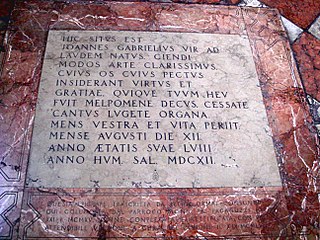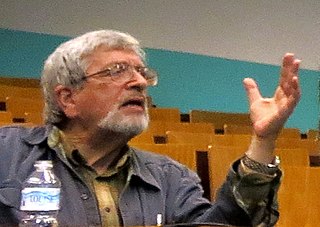Related Research Articles
Musicology is the scholarly analysis and research-based study of music. Musicology departments traditionally belong to the humanities, although some music research is scientific in focus. Some geographers and anthropologists have an interest in musicology so the social sciences also have an academic interest. A scholar who participates in musical research is a musicologist.
Music history, sometimes called historical musicology, is a highly diverse subfield of the broader discipline of musicology that studies music from a historical point of view. In theory, "music history" could refer to the study of the history of any type or genre of music. In practice, these research topics are often categorized as part of ethnomusicology or cultural studies, whether or not they are ethnographically based. The terms "music history" and "historical musicology" usually refer to the history of the notated music of Western elites, sometimes called "art music".

Giovanni Gabrieli was an Italian composer and organist. He was one of the most influential musicians of his time, and represents the culmination of the style of the Venetian School, at the time of the shift from Renaissance to Baroque idioms.
Andrea Gabrieli was an Italian composer and organist of the late Renaissance. The uncle of the somewhat more famous Giovanni Gabrieli, he was the first internationally renowned member of the Venetian School of composers, and was extremely influential in spreading the Venetian style in Italy as well as in Germany.

A madrigal is a form of secular vocal music most typical of the Renaissance and early Baroque (1600–1750) periods, although revisited by some later European composers. The polyphonic madrigal is unaccompanied, and the number of voices varies from two to eight, but usually features three to six voices, whilst the metre of the madrigal varies between two or three tercets, followed by one or two couplets. Unlike the verse-repeating strophic forms sung to the same music, most madrigals are through-composed, featuring different music for each stanza of lyrics, whereby the composer expresses the emotions contained in each line and in single words of the poem being sung.

Christopher Jarvis Haley Hogwood was an English conductor, harpsichordist, writer, and musicologist. Founder of the early music ensemble the Academy of Ancient Music, he was an authority on historically informed performance and a leading figure in the early music revival of the late 20th century.
Giovanni Croce was an Italian composer of the late Renaissance, of the Venetian School. He was particularly prominent as a madrigalist, one of the few among the Venetians other than Monteverdi and Andrea Gabrieli.
Giovanni Bassano was an Italian composer associated with the Venetian School of composers and a cornettist of the late Renaissance and early Baroque eras. He was a key figure in the development of the instrumental ensemble at the basilica of San Marco di Venezia. His detailed book on instrumental ornamentation has survived. It is a rich resource for research in contemporary performance practice. Bassano was most responsible for the performance of the music of Giovanni Gabrieli, who would emerge as one of the most renowned members of the Venetian School.

Richard Filler Taruskin was an American musicologist and music critic who was among the leading and most prominent music historians of his generation. The breadth of his scrutiny into source material as well as musical analysis that combines sociological, cultural, and political perspectives, has incited much discussion, debate and controversy. He regularly wrote music criticism for newspapers including The New York Times. He researched a wide variety of areas, but a central topic was the Russian music of the 18th century to present day. Other subjects he engaged with include the theory of performance, 15th-century music, 20th-century classical music, nationalism in music, the theory of modernism, and analysis. He is best known for his monumental survey of Western classical music, the six-volume Oxford History of Western Music. He received several awards, including the first Noah Greenberg Award from the American Musicological Society in 1978, and the Kyoto Prize in Arts and Philosophy in 2017.
Alfonso Ferrabosco the younger was an English composer and viol player of Italian descent. He straddles the line between the Renaissance and Baroque eras.
The year 1609 in music involved some significant events.
Georgina Emma Mary Born, is a British academic, anthropologist, musicologist and musician. As a musician she is known as Georgie Born and for her work in Henry Cow and with Lindsay Cooper.
Laurence Dreyfus, FBA is an American musicologist and player of the viola da gamba who was University Lecturer and Fellow of Magdalen College, Oxford.
Sir Albert Raymond Maillard Carr was an English historian specialising in the history of Spain, Latin America, and Sweden. From 1968 to 1987, he was Warden of St Antony's College, Oxford.
Sonata pian' e forte was composed by Italian composer and organist Giovanni Gabrieli and published in 1597. This is one of the earliest known pieces of music to specify loud and quiet passages in print..
Domenico Maria Ferrabosco was an Italian composer and singer of the Renaissance, and the eldest musician in a large prominent family from Bologna. He spent his career both in Bologna and Rome. His surviving music is all vocal, consisting of madrigals and motets, although he is principally known for his madrigals, which musicologist Alfred Einstein compared favorably to those of his renowned contemporary Cipriano de Rore.
Alfonso Ferrabosco (junior) was an English composer and court musician.

Drexel 4302, also known as the Sambrook Book based on an inscription from a former owner, Francis Sambrook, is a music manuscript containing vocal and keyboard music from Italian and British composers, documenting the transition from Renaissance to Baroque music. Though literature on the manuscript has assumed the copyist was Francis Tregian the Younger, recent analysis has demolished that hypothesis.
References
- 1 2 3 4 5 Patricia Brown (2001). "Charteris, Richard". Grove Music Online . Oxford Music Online. Oxford University Press. doi:10.1093/gmo/9781561592630.article.47777.